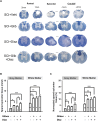Timed sulfonylurea modulation improves locomotor and sensory dysfunction following spinal cord injury
- PMID: 39148545
- PMCID: PMC11324438
- DOI: 10.3389/fphar.2024.1440198
Timed sulfonylurea modulation improves locomotor and sensory dysfunction following spinal cord injury
Abstract
Traumatic spinal cord injury (SCI) results in immediate tissue necrosis and delayed secondary expansion of neurological damage, often resulting in lifelong paralysis, neurosensory dysfunction, and chronic pain. Progressive hemorrhagic necrosis (PHN) and excessive excitation are the main sources of secondary neural injury. Recent approaches to attenuate PHN by glibenclamide can improve locomotor function after SCI. However, use of glibenclamide can exacerbate development of SCI-induced chronic pain by inhibiting KATP channels to increase neuronal excitation and glial activation. In this study, we explored a treatment strategy involving administration of glibenclamide, which suppresses PHN, and diazoxide, which protects against neuronal excitation and inflammation, at different time intervals following spinal cord contusion. Our goal was to determine whether this combined approach enhances both sensory and motor function. Contusive SCI was induced at spinal segment T10 in adult rats. We found that KATP channels opener, diazoxide, decreased the hyperexcitability of primary sensory neurons after SCI by electrophysiology. Timed application of glibenclamide and diazoxide following contusion significantly improved locomotor function and mitigated development of SCI-induced chronic pain, as shown by behavioral evidence. Finally, we found that timed application of glibenclamide and diazoxide attenuates the inflammatory activity in the spinal cord and increases the survival of spinal matters following SCI. These preclinical studies introduce a promising potential treatment strategy to address SCI-induced dysfunction.
Keywords: ATP-gated potassium channels; chronic pain; diazoxide; glibenclamide; spinal cord injury.
Copyright © 2024 Xu, Maskey, Wu and Yang.
Conflict of interest statement
The authors declare that the research was conducted in the absence of any commercial or financial relationships that could be construed as a potential conflict of interest.
Figures







Similar articles
-
Enhancing KCNQ Channel Activity Improves Neurobehavioral Recovery after Spinal Cord Injury.J Pharmacol Exp Ther. 2020 Apr;373(1):72-80. doi: 10.1124/jpet.119.264010. Epub 2020 Jan 22. J Pharmacol Exp Ther. 2020. PMID: 31969383 Free PMC article.
-
Independent evaluation of the effects of glibenclamide on reducing progressive hemorrhagic necrosis after cervical spinal cord injury.Exp Neurol. 2012 Feb;233(2):615-22. doi: 10.1016/j.expneurol.2010.11.016. Epub 2010 Dec 9. Exp Neurol. 2012. PMID: 21145891 Free PMC article.
-
Administration of low dose estrogen attenuates persistent inflammation, promotes angiogenesis, and improves locomotor function following chronic spinal cord injury in rats.J Neurochem. 2016 May;137(4):604-17. doi: 10.1111/jnc.13610. Epub 2016 Apr 12. J Neurochem. 2016. PMID: 26998684 Free PMC article.
-
Endothelial sulfonylurea receptor 1-regulated NC Ca-ATP channels mediate progressive hemorrhagic necrosis following spinal cord injury.J Clin Invest. 2007 Aug;117(8):2105-13. doi: 10.1172/JCI32041. J Clin Invest. 2007. PMID: 17657312 Free PMC article.
-
Neuronal-Glial Interactions Maintain Chronic Neuropathic Pain after Spinal Cord Injury.Neural Plast. 2017;2017:2480689. doi: 10.1155/2017/2480689. Epub 2017 Aug 29. Neural Plast. 2017. PMID: 28951789 Free PMC article. Review.
Cited by
-
Neurological Emergency Treatment Strategy: A Neuron-Targeted Regulation System for Reactive Oxygen Species Metabolism through Ferroptosis Modulation.ACS Nano. 2025 Mar 11;19(9):8753-8772. doi: 10.1021/acsnano.4c15705. Epub 2025 Feb 25. ACS Nano. 2025. PMID: 39996314
References
-
- Basso D. M., Beattie M. S., Bresnahan J. C., Anderson D. K., Faden A. I., Gruner J. A., et al. (1996). MASCIS evaluation of open field locomotor scores: effects of experience and teamwork on reliability. Multicenter Animal Spinal Cord Injury Study. J. Neurotrauma 13 (7), 343–359. 10.1089/neu.1996.13.343 - DOI - PubMed
-
- Bedi S. S., Yang Q., Crook R. J., Du J., Wu Z., Fishman H. M., et al. (2010). Chronic spontaneous activity generated in the somata of primary nociceptors is associated with pain-related behavior after spinal cord injury. J. Neurosci. 30 (44), 14870–14882. 10.1523/JNEUROSCI.2428-10.2010 - DOI - PMC - PubMed
Grants and funding
LinkOut - more resources
Full Text Sources
Research Materials

